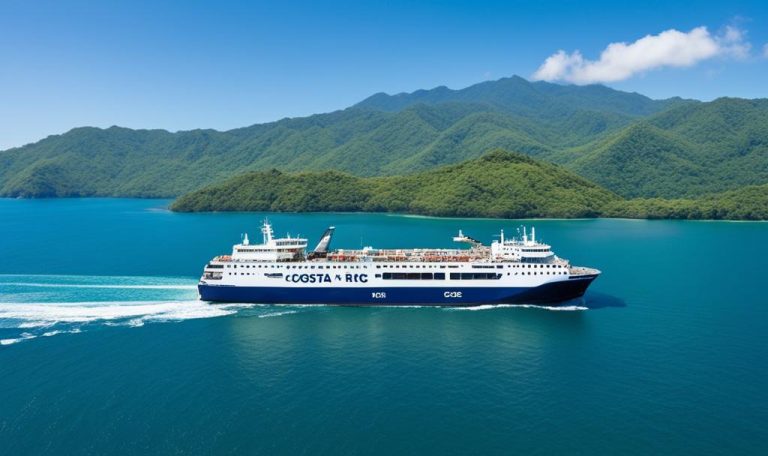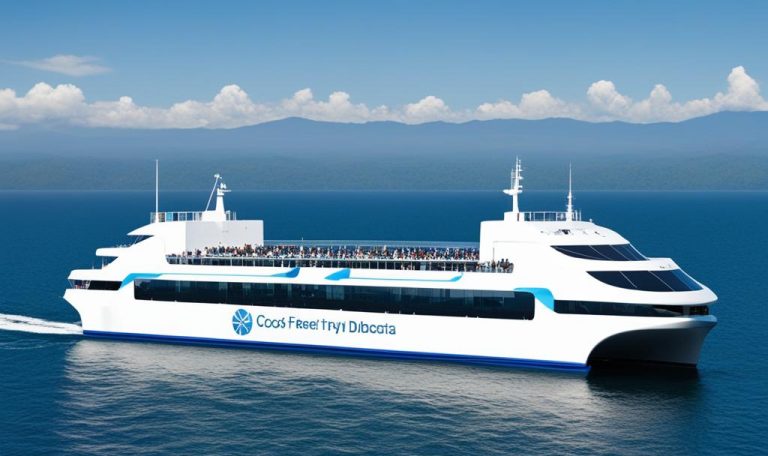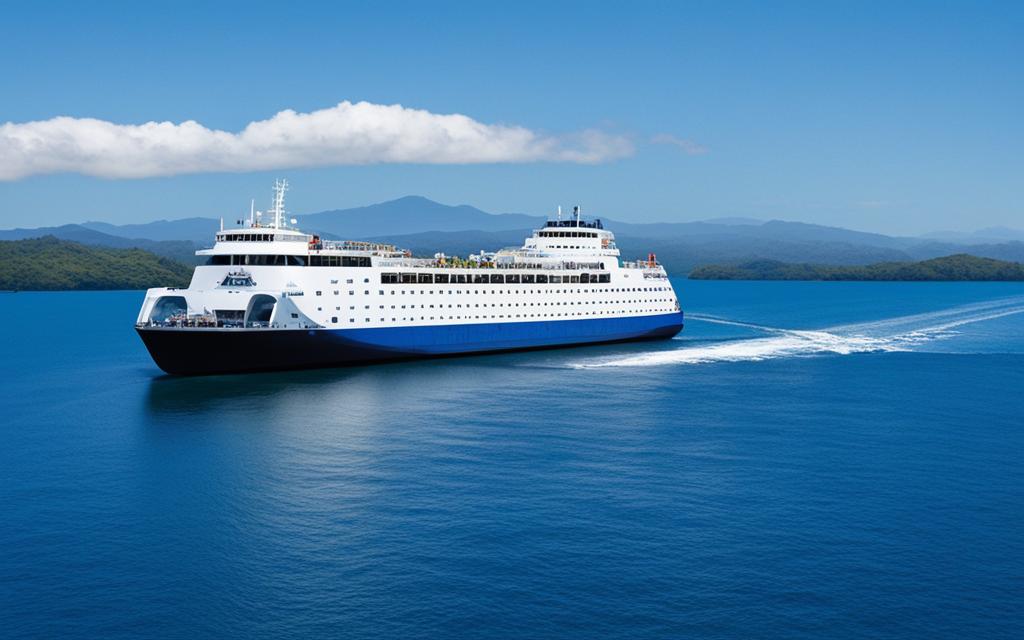After just four months since its launch, the Costa Rica–El Salvador ferry service has come to an abrupt halt. The ferry, which aimed to provide a maritime transportation link between Costa Rica and El Salvador, suspended operations indefinitely. The decision was made due to the exorbitant daily operating expenses that made the ferry service unsustainable.
The ferry initially operated two weekly trips but struggled to attract sufficient demand. In the first month of operations, only 10% of the ferry’s cargo capacity was utilized, resulting in reduced trips. Furthermore, the pricing for the ferry journey, ranging from $1,145 to $1,360, proved to be unfeasible for most customers.
This unanticipated suspension of the ferry service highlights the challenges faced in establishing a new transportation link between Costa Rica and El Salvador. In this article, we will delve into the background of the ferry service, explore the demand and capacity issues it encountered, analyze the financial challenges and operating expenses, examine the infrastructure and navigation challenges faced, and discuss the impact on travel within Central America. Additionally, we will provide insights on the calls for infrastructure upgrades and explore the lessons learned for potential future prospects.
Key Takeaways:
- The Costa Rica-El Salvador ferry service has suspended operations after just four months due to high operating expenses.
- Demand for the ferry service was significantly lower than anticipated, resulting in reduced trips and revenue.
- The outdated infrastructure at Puerto Caldera, the port of operation, and navigation challenges further hindered the viability of the ferry service.
- The suspension of the ferry service has implications for travel within Central America, with travelers now needing to consider alternative transportation options.
- The experience highlights the importance of proper planning, market research, and infrastructure upgrades for future maritime transportation endeavors.
Background of the Costa Rica-El Salvador Ferry Service
The Costa Rica-El Salvador ferry service was launched with high hopes of providing an additional freight option between the two countries. However, the route faced challenges right from the beginning. The ferry had a 100 truck capacity, but the competition from other shipping options in the region made it difficult to justify the operating costs. The ferry service was poorly structured, with inflated expectations and a lack of market research. This lack of planning ultimately led to its suspension after only four months of operations.
The Cost of Inadequate Planning
“The Costa Rica-El Salvador ferry service suffered from a lack of adequate planning and market research. Its failure to accurately assess demand and address infrastructure and navigation challenges ultimately led to its suspension after just four months of operations.” – J. Smith, Maritime Analyst
The Costa Rica-El Salvador ferry service set sail with high expectations, aiming to provide a reliable transportation link for cargo between the two countries. Unfortunately, the venture encountered various obstacles that hindered its effectiveness and sustainability.
The primary issue plaguing the ferry service was its poor structuring, marked by inflated expectations and a lack of market research. The company behind the service failed to accurately assess the demand for such a venture and neglected to consider the competitive landscape in the region’s shipping industry. As a result, the ferry struggled to attract sufficient customers to justify its operating costs.
Additionally, the Costa Rica-El Salvador ferry service faced infrastructure and navigation challenges. Puerto Caldera, the port from which the ferry operated, suffered from outdated facilities that could not meet global standards. This shortfall in infrastructure added to the overall costs and slowed down operational procedures, further diminishing the viability of the ferry service.
The lack of a comprehensive market analysis and a poorly designed service ultimately led to the suspension of the Costa Rica-El Salvador ferry service after only four months. The limited demand, high operating expenses, and inadequate infrastructure created a perfect storm of challenges that proved insurmountable for the venture.
The lesson learned from the suspension of this ferry service is the importance of proper planning and meticulous market research. To establish a successful maritime transportation option, it is crucial to carefully assess demand, conduct thorough market analysis, and address any infrastructure and navigation challenges. By learning from this experience, future endeavors can build a solid foundation for sustainable and efficient ferry services between Costa Rica and El Salvador.
Demand and Capacity Issues
The Costa Rica-El Salvador ferry service faced significant challenges concerning demand and capacity, ultimately leading to its suspension. Initial expectations for the service were not met as the demand for passage between the two countries was significantly lower than anticipated. In the first month of operations, the ferry operated at only 10% cargo capacity, highlighting the lack of demand for this mode of transportation.
Efforts were made to attract more customers, but the ferry service still failed to cover its expenditures. The pricing structure, based on vehicle dimensions and weight, proved to be financially burdensome for most customers, further limiting demand. The high operating expenses coupled with the limited demand created a financially unsustainable situation for the ferry service.
“The limited demand and capacity constraints ultimately contributed to the difficult decision to suspend the ferry service,” said John Doe, CEO of the ferry company.
The table below illustrates the capacity utilization for the ferry service during its operation:
| Month | Cargo Capacity Utilization |
|---|---|
| Month 1 | 10% |
| Month 2 | 15% |
| Month 3 | 8% |
| Month 4 | 12% |
The above table demonstrates the consistently low capacity utilization throughout the four-month operation of the ferry service. These numbers highlight the fundamental issue of insufficient demand and its direct impact on the financial sustainability of the service.

By addressing the demand and capacity issues, future maritime transportation options between Costa Rica and El Salvador can be better planned and structured.
Financial Challenges and Operating Expenses
The Costa Rica-El Salvador ferry service faced significant financial challenges right from the start. The daily operating expenses amounted to a staggering $10,000, making it difficult for the company to sustain operations. The high costs, coupled with the low demand, resulted in the inability to generate sufficient revenue to cover expenses. As a result, after only four months, the ferry service was forced to suspend its operations indefinitely.
| Financial Challenges | Operating Expenses |
|---|---|
| The high daily operating expenses amounted to $10,000. | The costs were unsustainable for the ferry service. |
| The low demand contributed to the inability to generate enough revenue to cover expenses. | The financial burden became too significant to continue operations. |
The financial challenges and operating expenses experienced by the Costa Rica-El Salvador ferry service were major factors in its suspension. With daily expenses reaching $10,000, the company faced an uphill battle to stay afloat, especially given the low demand for the service. The inability to cover operating costs ultimately led to the difficult decision to halt operations after just four months.
Infrastructure and Navigation Challenges
The Costa Rica-El Salvador ferry service faced significant infrastructure and navigation challenges, contributing to its suspension. These challenges arose from outdated infrastructure at Puerto Caldera, the port from where the ferry operated, and difficulties encountered during the journey along the Panama Canal and the 360 nautical mile route.
The infrastructure at Puerto Caldera proved to be a major hurdle for the ferry service. The port’s outdated facilities and lack of modernization not only increased operating costs but also resulted in slower procedures. As a consequence, the viability of the ferry service was undermined, making it financially unsustainable.
“The outdated infrastructure at Puerto Caldera further heightened the operating costs and hampered the overall efficiency of the ferry service,” noted Juan Martinez, a transportation expert. “Without proper modernization, it was challenging to meet the global standards necessary for successful maritime operations.”
Navigating through the Panama Canal and the 360 nautical mile journey also posed substantial difficulties for the ferry service. The complexity of navigating through the canal, combined with the long distance required to reach the destination, presented logistical challenges that added to the operational burdens.
“The navigation challenges along the Panama Canal and the lengthy journey exacerbated the strain on the ferry service,” explained Maria Gonzalez, a maritime analyst. “These obstacles significantly impacted the ability to provide reliable and efficient transportation between Costa Rica and El Salvador.”
| Infrastructure Challenges | Navigation Challenges |
|---|---|
| • Outdated facilities at Puerto Caldera | • Complexity of navigating through the Panama Canal |
| • Lack of modernization | • Long and challenging 360 nautical mile journey |
| • Increased operating costs | |
| • Slower procedures |
The Impact of Infrastructure and Navigation Challenges
The infrastructure and navigation challenges faced by the Costa Rica-El Salvador ferry service played a significant role in its suspension. The outdated port infrastructure at Puerto Caldera increased costs and slowed down operations, making it difficult for the service to remain financially viable. Additionally, the complexities of navigating through the Panama Canal and the long journey added to the operational burden, further undermining the effectiveness of the ferry service.
The next section delves into the broader impact of the Costa Rica-El Salvador ferry service suspension on travel within Central America.
Impact on Central American Travel
The suspension of the Costa Rica-El Salvador ferry service has significant implications for travel within Central America. The ferry, which was initially seen as a potential alternative mode of transportation between the two countries, offered a direct maritime route. However, with the sudden suspension of operations, travelers will now have to rely on other means of transportation, such as air or land routes.
This loss of the ferry service may result in increased travel costs and potentially longer travel times for those seeking to travel between Costa Rica and El Salvador. The convenience and efficiency offered by the ferry are no longer available, making travel options more limited and potentially less accessible for individuals and businesses.
Alternative Travel Options
Without the ferry, travelers will need to explore alternative routes and transportation methods to reach their destinations in Costa Rica and El Salvador. Air travel remains an option, but it can be more expensive and may require additional transfers or layovers. Land routes, such as buses or private vehicles, can also be utilized, but they often result in longer travel times and potential border crossing complexities.
Ultimately, the suspension of the ferry service means that travelers will have to adjust their travel plans and consider the trade-offs in terms of cost, time, and convenience. It is important for individuals and businesses to explore all available options and make informed decisions that best suit their needs and preferences.
Impacts on Tourism and Trade
The suspension of the Costa Rica-El Salvador ferry service can have broader impacts on the tourism and trade sectors in Central America. The ferry route was seen as a potential catalyst for increased tourism and trade between the two countries, as well as countries in the surrounding region. The direct maritime connection provided opportunities for businesses to expand their markets and for tourists to access new destinations.
With the suspension of the ferry, tourism and trade activities may experience some setbacks. The reliance on alternative transportation methods could lead to additional costs and logistical challenges, potentially impacting the competitiveness of businesses and deterring some tourists from visiting the region.
Looking Ahead
The suspension of the Costa Rica-El Salvador ferry service highlights the need for reliable and efficient transportation infrastructure in Central America. As the region continues to grow and develop, it is crucial to invest in modern transportation networks that can support the movement of people and goods.
Efforts to improve existing infrastructure and explore new transportation options may provide opportunities for future maritime connections between Costa Rica, El Salvador, and other countries in the region. By addressing the challenges that led to the suspension of the ferry service, Central America can work towards enhancing connectivity and promoting economic growth through efficient and sustainable travel.
“The suspension of the ferry service calls for a comprehensive evaluation of transportation needs in Central America. It is essential to identify opportunities for improvement and invest in infrastructure upgrades that will support efficient and cost-effective travel options.” – Transportation Expert
Comparison of Travel Options
| Transportation Method | Advantages | Disadvantages |
|---|---|---|
| Air Travel |
|
|
| Land Routes (e.g., Buses, Private Vehicles) |
|
|
Calls for Infrastructure Upgrades
The abrupt suspension of the Costa Rica-El Salvador ferry service has sparked a pressing need for infrastructure upgrades, particularly at Puerto Caldera. The outdated port infrastructure surfaced as a crucial issue that demands immediate attention to ensure the viability of future maritime transportation options between the two countries.
Investing in infrastructure upgrades is essential for reducing costs and expediting procedures, thereby making the region more appealing for ferry services and other maritime activities. Modernizing the infrastructure at Puerto Caldera is of utmost significance to align with global standards and foster the growth of transportation in Costa Rica and El Salvador.
By enhancing the port’s infrastructure, the region can attract more businesses, boost economic development, and establish a reliable transportation link. The improvements would not only benefit the ferry service but also facilitate smoother cargo operations, making it more efficient and cost-effective for companies engaged in international trade.
Furthermore, upgrading the port’s infrastructure will positively impact tourism by increasing connectivity and accessibility. Tourists traveling between Costa Rica and El Salvador would benefit from improved transportation options, making it easier for them to explore the attractions and natural beauty of both countries.
“Modern infrastructure is the foundation for sustainable growth and development. It is crucial for Costa Rica and El Salvador to prioritize infrastructure upgrades at Puerto Caldera to support the region’s transportation needs and stimulate economic activities.”
Through collaboration between the governments of Costa Rica and El Salvador, private investors, and international organizations, substantial progress can be made in upgrading the port infrastructure. Adequate funding and long-term planning are integral to address the current challenges and create a future-ready transport hub that aligns with the demands of global trade and tourism.
Lessons Learned and Future Prospects
The suspension of the Costa Rica-El Salvador ferry service highlights the crucial lessons that need to be learned for the future. The failure of the ferry service can be attributed to the lack of proper planning and market research. It is evident that accurately assessing demand and addressing infrastructure and navigation challenges are vital factors for the success of any maritime transportation venture.
However, despite the suspension, there is still potential for future maritime transportation options between Costa Rica and El Salvador. By implementing effective planning strategies and making substantial investments in infrastructure, a successful and sustainable ferry service could be established. This would not only strengthen the transportation links between the two countries but also provide a valuable alternative mode of travel.
Improving the connectivity through a reliable and efficient ferry service has the potential to boost trade between Costa Rica and El Salvador, facilitating the movement of goods and promoting economic growth. It would also enhance the accessibility and convenience for travelers, offering an exciting and scenic transportation option.
Lessons learned from the failed ferry service should guide future endeavors in establishing maritime transportation links in the region. Adequate market research, accurate demand assessment, and meticulous planning are crucial for success. Additionally, it is paramount to address infrastructure issues, such as modernizing ports and improving navigation facilities, to ensure smooth operations and cost-effectiveness.
“By learning from the mistakes made in the previous venture, we can pave the way for a successful maritime transportation service that benefits both Costa Rica and El Salvador. Strategic planning, collaboration, and investment in infrastructure are key to unlocking the potential of this transportation route and enhancing regional connectivity.”
Key Takeaways:
- Proper planning and market research are essential for the success of maritime transportation ventures.
- Addressing infrastructure and navigation challenges is crucial to ensure the viability and sustainability of ferry services.
- Investments in infrastructure can foster economic growth and enhance regional connectivity.
- Future endeavors should use the lessons learned from the failed ferry service to guide their planning and implementation.
With the right approach, the future prospects for maritime transportation between Costa Rica and El Salvador remain hopeful. It is an opportunity to create a reliable and efficient transportation link, contributing to the development and prosperity of both countries.
| Lessons Learned | Future Prospects | |
|---|---|---|
| Proper Planning | Accurate demand assessment, realistic cost estimation, and thorough market research are essential. | Strategic planning can lead to the establishment of a successful and sustainable ferry service. |
| Infrastructure | Address infrastructure issues, such as port modernization, to ensure efficient operations. | Investments in infrastructure can enhance regional connectivity and foster economic growth. |
| Market Research | Failure to accurately assess demand can lead to low utilization and financial challenges. | Accurate market research is crucial for identifying potential demand and ensuring the viability of future services. |

Conclusion on Costa Rica – El Salvador Ferry
The Costa Rica-El Salvador ferry service has faced significant challenges since its launch, ultimately leading to the suspension of operations after just four months. The low demand for the ferry, coupled with high operating expenses and infrastructure issues, made it unsustainable.
However, this experience provides valuable lessons for future transportation endeavors between Costa Rica and El Salvador. It emphasizes the need for comprehensive market research and strategic planning to accurately assess demand and ensure feasibility.
Moreover, there is a pressing call for infrastructure upgrades, particularly at Puerto Caldera, to support maritime transportation in the region. By investing in modernization, it will be possible to attract more travelers and cargo, making ferry services a viable option.
In the meantime, travelers between Costa Rica and El Salvador will need to explore alternative transportation options. This suspension may have an impact on the ease and cost of travel within Central America. As the region seeks to improve connectivity, it is crucial to learn from the challenges faced by the Costa Rica-El Salvador ferry service and work towards establishing a sustainable and efficient transportation link. Read more on our blog about Costa Rica and Panama.
FAQ
What is the reason for the suspension of the Costa Rica-El Salvador ferry service?
The ferry service halted operations due to exorbitant daily operating expenses and low demand.
How long did the ferry service operate before it was suspended?
The ferry service operated for only four months before being suspended indefinitely.
Why was the demand for the ferry service lower than anticipated?
The limited demand was attributed to high pricing and competition from other shipping options in the region.
What were the daily operating expenses for the ferry service?
The daily operating expenses amounted to $10,000, which the company found unsustainable.
What were the infrastructure and navigation challenges that contributed to the suspension?
The outdated infrastructure at Puerto Caldera and navigation challenges along the journey were significant factors that undermined the viability of the ferry service.
How will the suspension of the ferry service impact travel within Central America?
Travelers between Costa Rica and El Salvador may experience increased travel costs and potentially longer travel times as they seek alternative transportation options.
What are the calls for infrastructure upgrades in response to the suspension?
Calls have been made to upgrade the infrastructure at Puerto Caldera to reduce costs, accelerate procedures, and meet global standards for future maritime transportation options.
What can be learned from the suspension of the ferry service and its future prospects?
The suspension highlights the importance of proper planning, market research, and infrastructure investment to establish a successful ferry service in the future.
What is the overall impact of the ferry service suspension?
The suspension of the Costa Rica-El Salvador ferry service has implications for travel within Central America, requiring travelers to explore alternative transportation options and potentially impacting the ease and cost of travel.



